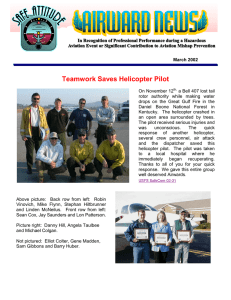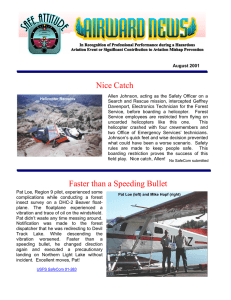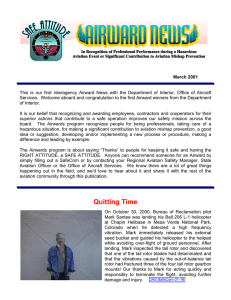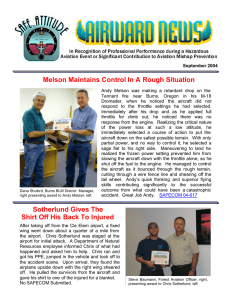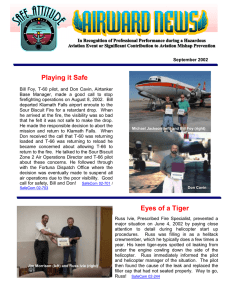SAFECOM Summary June 2012 SAFECOM’s by Aircraft Type
advertisement
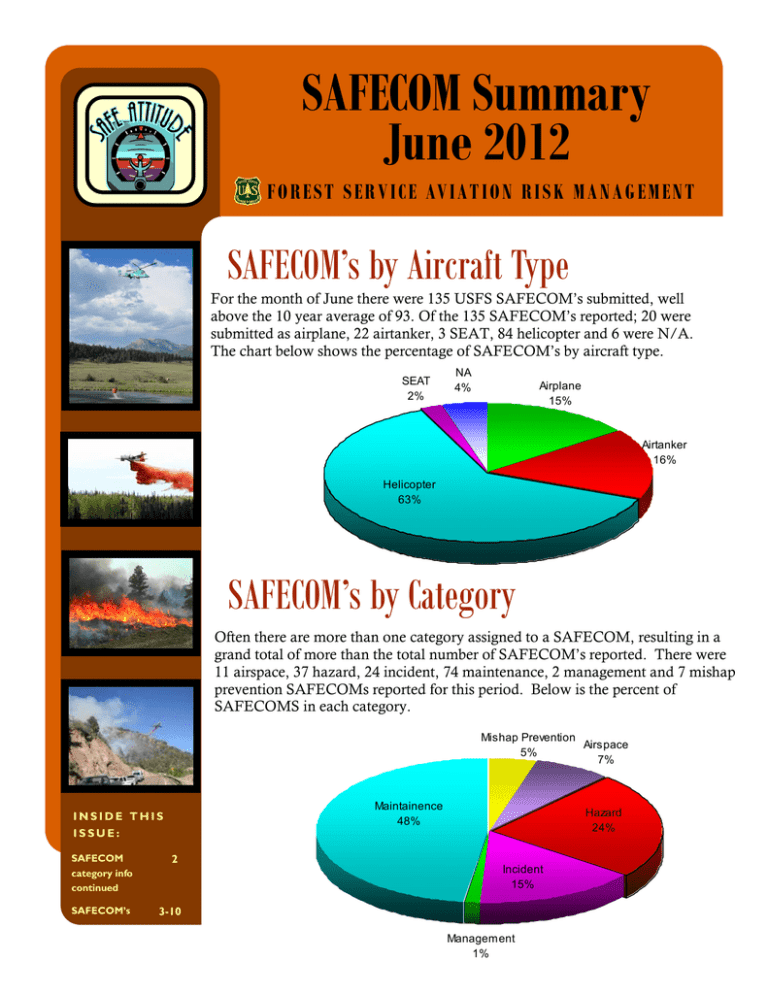
SAFECOM Summary
June 2012
F O R E S T S E R V I C E AV I AT I O N R I S K M A N A G E M E N T
SAFECOM’s by Aircraft Type
For the month of June there were 135 USFS SAFECOM’s submitted, well
above the 10 year average of 93. Of the 135 SAFECOM’s reported; 20 were
submitted as airplane, 22 airtanker, 3 SEAT, 84 helicopter and 6 were N/A.
The chart below shows the percentage of SAFECOM’s by aircraft type.
SEAT
2%
NA
4%
Airplane
15%
Airtanker
16%
Helicopter
63%
SAFECOM’s by Category
Often there are more than one category assigned to a SAFECOM, resulting in a
grand total of more than the total number of SAFECOM’s reported. There were
11 airspace, 37 hazard, 24 incident, 74 maintenance, 2 management and 7 mishap
prevention SAFECOMs reported for this period. Below is the percent of
SAFECOMS in each category.
Mishap Prevention
Airspace
5%
7%
Maintainence
48%
INSIDE THIS
ISSUE:
SAFECOM
category info
continued
SAFECOM’s
2
Hazard
24%
Incident
15%
3-10
Management
1%
PAGE
2
SAFECOM’s by Category continued
AIRSPACE - There were 11 airspace events reported; 6 were intrusions and 4 were
conflicts in which one was classified as an Incident With Potential (IWP). This IWP
involved a National Guard helicopter and an exclusive use helicopter that came in
close contact with each other at an airport that was being used as an incident helibase.
HAZARD - There were 38 hazard events reported. Communications accounted for a
third of the hazards reported. Ground radio and repeater problems continued to be
the most reported communication issue this year. Due to these problems, some units
have had to temporarily ground aviation activities and/or develop back up plans utilizing neighboring units. Mission equipment was the next most reported hazard, most
of these pertained to issues with rappel equipment and aerial ignition equipment.
INCIDENT - Mission Equipment was the most reported in this category and most of
them were associated with rappel and aerial ignition. There were 5 precautionary
landings mostly due to mechanical problems. There were 4 dropped loads and 3
dragged loads reported. Three incidents were classified as IWP’s. Along with the airspace event mentioned above there was an airtanker that made a gear up landing and
an airtanker that was unable to use the planned exit on a drop and barely cleared a
ridge.
MAINTENANCE - Issues involving maintenance were present in 48% of the
SAFECOMs, which is normal. There were 74 maintenance reports, the most reported were: 10 engine issues including one failure; 8 hydraulic; 8 oil; 7 electrical; 6 caution light and 5 gear box.
MANAGEMENT - There were two internal management SAFECOM’s reported;
one regarding working with the National Guard and another on a pilot that did not
meet flight hour requirements.
MISHAP PREVENTION - There were 7 reports in this category: great SMS/CRM
by rappel spotters; radio operator and parking tenders advising aircraft of issues; IMT
developing guide to work with National Guard; crew chief calling off maintenance
due to approaching thunderstorms, and a FBO manager noticing bad fuel. Good job!
The loss of six of our aerial firefighters and the injuries sustained by the two survivors of MAFFS 7
comes with great sadness. Our thoughts and prayers go out to their families and friends and to the
MAFFS 7 survivors, Andrew Huneycutt and Josh Marlow.
SAFECOM’s
PAGE
3
These are samplings from the SAFECOM’s for the month of June. We hope you will select a couple
of them a day to discuss and use the lessons learned in you daily briefing. Some of the SAFECOM’s
have been edited due to length, to read the SAFECOM in it’s entirety, please click on the link.
SAFECOM 12-0298: Tanker was assigned to the George Fire, at 1300 hours aircraft lifted off for the fire
and upon his return, the pilot informed the tanker base that his left landing gear would not come down.
The Pilot said they had recycled the landing gear several times and stated they were declaring an emergency. At 1336 notified dispatch of the emergency and to start the emergency equipment. The Pilot and
tanker base manager discussed options on airports with crash rescue units. Fresno and Lemoore Naval
Base, were talked about and the pilot decided to head toward to Minden airport. The Porterville Airtanker base maintained radio contact with Tanker XX for about 120 miles from Porterville Ca., also had
Fresno Airtanker base maintain radio contact with the tanker. CORRECTIVE ACTION: RASM:
This event ended with the aircraft landing with partial gear extension and is currently under investigation
as an IWP. The communication and response to this emergency landing was exceptional. There was
significant damage to the aircraft but no injuries to the flight crew. NTSB classified this as an incident.
SAFECOM 12-0303: During PSD operations inflight communications failed due to the starter generator
seizure. After unsuccessful attempts to communicate with inflight personnel, the PSD operator secured
the PSD machine. At the time of the communication failure, PSD operations were between live run
phases of the mission. The pilot and firing boss, visually notified the PSD operator through the use of
hand signals to secure the machine to ensure inadvertent ignitions. The pilot squawked ``radio failure``
(7600 on the aircraft transponder) and began immediate troubleshooting procedures while en route back
to helibase. CORRECTIVE ACTION: Immediate shut-down of PSD ignitions and immediate return
to base of operations were implemented. the use of hand signals in the cabin enabled crewmembers to
communicate and ensure that operations were to cease and a return to base was imminent. Pilot initiated
inflight emergency procedures including resetting aircraft avionics circuit breakers, restoring communications with air attack and helibase prior to landing at helibase. Conducted AAR with all personnel involved. Mechanic diagnosed the problem as a starter generator failure. The mechanic replaced the starter
generator and conducted a run up, resolving the issue. RASM Comments: These folks did a good job responding to an unexpected situation. Making sure positive communication occurred so everyone knew
what to do was critical. The AMI was contacted and the aircraft returned to contract availability. Thanks
for sharing what worked for you.
SAFECOM 12-0332: While conducting rookie rappel training in a live rappel the left outboard trainee
rappeller hooked -up backwards and was given the sign to go to skid, the spotter realized the error as
both rappellers were transitioning to the skids. When the rappeller was on the skid the spotter gave reentry signal to the left rappeller to come back into the aircraft and put on seatbelt. Spotter then unhooked descent device and gave right side rappeller signal to re-enter aircraft and put on seatbelt and
spotter then un-hooked descent device of right rappeller. Spotter informed the pilot that he would be derigging descent devices and throwing ropes and returning to helibase. The error was immediately addressed by the Check Spotter, Lead Trainer and Spotter with the rookie rappeller. CORRECTIVE ACTION: The check spotter and lead trainer discussed the importance of hooking up correctly and checking descent device to both the spotter and trainee rappeller. RASM COMMENTS: AAR should be conducted and documented. The potential for serious outcomes in this type of incident requires a documented review.
PAGE
4
SAFECOM’s continued
SAFECOM 12-0372: Maintenance crew was performing scheduled MX on a CH54A, Main Rotor Head
Replacement. During the maintenance process a storm cell began to build over the Helibase. Thunder
became audible and the threat of lightening was apparent. When I walked to the ship to call “knock it
off” I realized the Crew Chief, had already practiced good Risk Management and called his crew off the
helicopter. I asked the HEMG to radio the Helibase Manager for weather information regarding the
proximity of lightening. The Helibase replied that they really do not have the capability to determine the
lightening situation. As a maintainer working out in the middle of an open area, that is an unacceptable
situation. Besides the atta boy I extended to the crew for calling “knock it off” the purpose of this
SAFECOM is to raise the question of why don`t we have that capability? DO we already and didn`t use
it. Can we get it. Helicopters with big fuel trucks next to them make nasty lightening magnets. Recall the
event in McCall? CORRECTIVE ACTION: RASM - predictive services is certainly an avenue to at
least establish the potential, but auditory and visual clues of impending electrical activity is still our best
defense on site. Afternoon T-storms capable of producing lightning happen with enough regularity in
Colorado that early morning maintenance is a viable mitigation. Good job at using the on site clues and
acting appropriately. There are however portable/handheld lightning detection equipment that alerts
you of lightning in the area or approaching the area. It is encouraged that devices such as these be investigated and utilized as a supplement to awareness.
SAFECOM 12-0382: I observed what I consider to be a near mid-air collision between a fully assigned
incident helicopter and a helicopter staged for emergency response. I was standing at the east end of the
airport between the old SEAT base tower and the crash-rescue building. I saw response helicopter H-XX
approach the airport from the NE. At the same time I heard pad 10 calling helibase on the deck frequency advising that H-XX was trying to contact them on the deck frequency. I did not hear H-XX on the
deck frequency and attempts to contact the helicopter by helibase were unsuccessful. At the same time,
Helicopter H-ABC was approaching the airport from the west to park adjacent to a hanger where ground
personnel were waiting to move aircraft out of impending severe weather. H-XX crossed over the ramp
with a SW heading, crossed over the taxiway, then turned to the east over the runway, flying down the
runway at about 200 ft AGL. They then turned north at the taxiway connector, then west, and continued
flying down the ramp to the west at about 200 ft AGL. At this point, H-ABC was descending to the ramp
to land next to the far west hanger. From my perspective it appeared the helicopters were on a collision
course. H-XX performed an evasive right turn and descent to the north. H-ABC continued with its intended approach and landed on the ramp. H-XX regained altitude and turned to the west and then south
to land at the apron at the far end of the taxiway. CORRECTIVE ACTION: RASM comments: Airspace conflicts are serious and can be catastrophic. The technical definition of a near-midair is two aircraft within 500 feet of each other. In this case, estimates put the aircraft within 200 feet of each other.
The event turned out to warrant being called an Incident With Potential (IWP) and a report separate of
the SAFECOM system was developed. Regardless of technicalities, the risk of airspace conflicts needs to
be mitigated. Discuss see and avoid: ensure folks are communication with each other: brief on flight patterns at the helibase. The team put good mitigations in place including AARs, briefings and check in protocols in responding to this event.
SAFECOM 12-0475: Right rear door latch came open during flight. Rear passenger held door closed until helicopter landed. Pilot notified helitack that a door was open and helitack closed the door. CORRECTIVE ACTION: Pilot, helicopter manager, and helibase manager looked at door latch with the mechanic and established that latch was working properly. Managers and pilot had a discussion about the
importance of making sure all doors are properly closed and checked before all flights. RASM Comments: With the new season beginning it is time to dust off the procedures.
SAFECOM’s continued
PAGE
5
SAFECOM 12-0309: During a proficiency rappel a rappeler’s belly bag came partially unclipped on the
left side from the harness. Procedurally during self-check, buddy check, and spotter check, there were no
abnormalities with the Click Lock Buckles. After rappeller was given the Begin Descent Signal, the rappeller proceeded to become inverted. That’s when the rappeller became aware of the movement of the belly
bag to the right side. The rappeller continued the rappel procedure. After the rappeller was off the skid the
rappeller noticed the left side Click Lock Buckle unclipped from the belly bag. The rappeller continued the
rappel without any further issue. CORRECTIVE ACTION: Regional Check Spotter Comments: An inspection of the equipment used was done by spotter and other rappellers. The event could not be replicated. Rappeller changed out Click Lock Buckles on harness and changed out belly bag. An inspection was
done again by spotter and harness was put back in service.
SAFECOM 12-0324: On my first longline mission on the fire I accidentally released the longline instead of
releasing the cargo from the remote hook. This happened after the cargo was placed on heli-spot 4. I then
landed at heli-spot 4 and was re-hooked by helitack. Continued on with longline cargo missions.
CORRECTIVE ACTION: A brief checklist has been developed to include the pre-flight checks along with
selecting the correct switch for release of cargo. R5 RASM. I had our HIP discuss the event with the pilot
to ensure there were no other issues with the aircraft or procedures, there were none. Pilot was extremely
forthcoming and has created a checklist to ensure this event will not reoccur. Rgn 5 HIP: discussed with
pilot as described, no further action.
SAFECOM 12-0418: I was called to the High Park Fire for Leadplane duty, with a student Leadplane
trainee in the left seat with myself as instructor in the right seat. Arriving on scene with two seats and two
heavy airtankers shortly behind I checked in with Air Attack who assigned us to coordinate with a HLCO
working about 5 type 1 helicopters. We did so and soon after, with coordination through HLCO made a
dry run through the drop area and checked the airtanker exit route. The exit route was rather compressed
between the smoke column and the terrain. After our seats arrived we coordinated a live run with HLCO
holding the helicopters, during which I saw a helicopter in the exit route and called off the live run. After
some further discussion with HLCO and Air Attack we were assured our run was clear. We proceeded to
make our live run with seats, at which point when fully committed to the run, the helicopter popped back
into view in the middle of our river drainage exit. Maneuvering room was limited, I called on the f/w frequency to the Air attack that the helicopter was still in our exit, and that I needed the helo to immediately
descend into the river, the air attack told the helo to stay low, and I repeated I needed them to descend into
the river for separation. After the seat run was completed and all aircraft were safe I told HLCO and Air
Attack that I was going to call off the heavy airtankers if coordination could not be exercised better. After a
discussion that the aircraft was not under HLCO control, and that it was indeed now clear of our exit, we
proceeded to drop our heavy airtankers. CORRECTIVE ACTION: After the shift was over, the Air Tactical Group Supervisor in control of the fire at the time, and myself sat down for an AAR and discussed
what had occurred, and what could be done to prevent this from occurring again in the future. During this
discussion it was determined that the helicopter was cleared into the river drainage by the ATGS without
advising the Leadplane of this. RASM—Know that this submission is greatly appreciated and contributes
profoundly to our data bank of lessons learned.
SAFECOM 12-0385: T-xxx, after returning from their first load of the day the parking tender in pit 1 noticed that there was hydraulic fluid leaking from the right hand engine. After informing the flight crew and
maintenance personnel they determined that the engine driven pump was defective. CORRECTIVE ACTION: They removed the defective unit and replaced it with a new one. The aircraft was returned to contract availability after the regional maintenance inspector reviewed the work. RASM Kudos to the parking
tender for the heads up and situational awareness!
PAGE
6
SAFECOM’s continued
SAFECOM 12-0410: For the third time in the last six PSD missions, we’ve had PSD balls hang up in the
feeder chutes. The balls get “caps” or halves of other balls on them and get stuck. These extra halves
don’t appear to be broken and we haven’t noticed excess permanganate in the hopper though we have
seen some ball seams that are not flush. This issue has occurred with both of our PSDs and several
PLDOs at all stages of the burns. CORRECTIVE ACTION: We cleared the chutes and checked the
hopper for any broken balls. We try to inspect the balls as we load them into the bags but unless we check
thousands of balls individually, there’s no guarantee we`ll find all the caps. RASM: Spoke with HOS
and he is aware of the problem and working with the aerial ignition group and manufacturer to resolve
the problem.
SAFECOM 12-0396: In the afternoon at H-7 on the fire, a thunderstorm built up over the fire, and started producing moderate rains and hail. In response to air attack’s command to suspend rotor wing operations, I loaded our crew into the helicopter and took off from H-7 in route back to the Helibase. After lift
off, air attack informed us, while on our way back to helibase to stop at H-5 and pick up two more helitack personnel from a different crew, and take them with us. In the confusion and weather, a flight manifest was not completed for the two additional passengers and their effects. CORRECTIVE ACTION:
A safety discussion was led about protocol for in ground, out of ground and jettison-able load limits, and
the importance of insuring that we as a crew do not exceed those limits. We also discussed the consequences of exceeding those limits. We also reproduced the flights altitude, cargo weight, fuel capacity
and personnel weights, which proved to be within the limits. RASM comments: A sense of urgency can
often lead us to accept unnecessary risk. Manifests are a safety control to the risk of overloading the aircraft. In this case, the payload was within limits, but making sure we do the performance planning is crucial. Kudos to the submitter for speaking up and sharing how they found themselves in the situation and
for the corrective actions implemented.
SAFECOM 12-0327: During Initial Rappeller Certification in Salmon Idaho a minimum of 25 Bourdon
1210BE snap hooks were replaced due to following defects. Gates sticking open, Detent pins not allowing the gate to open Both halves of the detent pin moving independently of each other. All defective snap
hooks were replaced by qualified rappel spotters. CORRECTIVE ACTION: Replaced snap hooks are
being returned to MTDC for return to the company for replacements. RASM COMMENTS: No further
action required. USFS Tech Bulletin 2012-02 was distributed as a result of this and other SAFECOMs.
Thanks again to the Rappel community for outstanding reporting.
SAFECOM 12-0403: Helicopter had been pre-positioned in Moriarty, NM. Was En route to Casper,
WY. for Incident. During first leg of Ferry Mission, Helicopter sustained bird strike to left rotor system.
Bird came from right to left across windscreen. Pilot did not have time to react and observed the bird
striking the lower third portion of the left blade. Pilot reported that upon striking the bird there was no
abnormal flight characteristics of aircraft. Pilot made notification to dispatch and informed them he
would be landing at the nearest airport to inspect of aircraft. CORRECTIVE ACTION: Notifications
were made to the local forest dispatch, the local GACC, the Regional maintenance inspector mechanic
and the Contracting Officer. The HMGB and contract mechanic reported to the aircraft. Upon inspection, the aircraft was found to have sustained no structural damage. Photos were taken and the Regional
maintenance inspector returned the Aircraft back to Availability status. RASM comments: Great response. The pilot landed and checked things out. Communication was good with all. Birds are an environmental hazard that we have few mitigations for. Awareness being the biggest tool we have. The pilot
responded to the situation well and his action to stop and check things out demonstrates good risk decision making.
SAFECOM’s continued
PAGE
7
SAFECOM 12-0459: At approximately 1720 hours helicopter XXX was involved in a longline cargo
mission on the ABC incident. The load consisted of water, MRES, miscellaneous spike camp supplies
and HazMat. (Fuel, chain saw bar oil). The load was built and separated properly, but while checking the
fuel jerry cans we failed to realize the pour spouts on the jerry cans were zip tied open and were DELIVERED THAT WAY FROM SUPPLY. Helicopter XXX began to lift the load, upon leaving the ground
the fuel cans shifted in the net and began to spill. The helibase ABRO noticed the leak and notified the
pilot of the leak. The pilot set the load down and released it, picked up a different load and continued the
mission. Approximately one gallon of fuel was spilt on the pad. CORRECTIVE ACTION: After the
incident the crew conducted an AAR about what happened. We reviewed the proper procedure to thoroughly check fuel jerry cans and make sure all valves are properly closed and proper ways to tape and
bundle a load to avoid excessive load shifting in the air… ACTING RASM Remarks: Thanks for the
SAFECOM so that others may learn from the experience! There were two (or more) opportunities to
catch the jerry cans zip-tied open and this was something that we haven’t been trained to catch on our
inspections. NOW WE KNOW, please share this SAFECOM with other crew members to brief this experience. I additionally suggest that supply: when the jerry cans are new/refurbished and are inspected,
PLACARD the jerry can with a red-tag attached to the zip-tie warning of removal of the zip-tie prior to
the jerry can’s use. Please inform all the fire cashes. Also, KUDO’s to the ABRO for the SA and the appropriate action!
SAFECOM 12-0415: The PSD machine is strapped inside the
helicopter using a belly strap and while in flight the strap split.
Before the strap goes under the belly of the helicopter, we asked
both mechanics {mechanic/relief mechanic} if it was going to
be a problem if the strap would sit on the search light. The two
mechanics said, it was ok to put the strap over the retractable
search light on the belly of the helicopter to secure the PSD machine, and as long as the pilot doesn’t turn on the light. We
have been doing Aerial Ignitions for the past two days and on
the second day, the fourth time going up, the strap burned in
half before burning operations. I notified the pilot and pulled
the straps back into the helicopter and showed the ends to the
pilot. When the pilot saw the tip of the straps, he knew then
that he had turned on the light. The reason this happened was
because he changed frequencies during the flight and turned the
switch to the on position. CORRECTIVE ACTION: We went
back to H30 to shut down and had an extra belly strap in the
PSD kit to replace it with the broken strap. While we were at
the helispot we talked about how we can avoid this from happening again because the switch is on the collective and does
not have a guard on it. We all came into an agreement that he
will make it one of his checks while we are doing PSD missions. RASM comments: This report demonstrates the value of a reporting culture. They came across a hazard and everyone else can learn from their
experience. The crew briefed locally on the hazard to help keep focus on where the switch is. The MEL
was being checked to see if pulling the circuit breaker would be another mitigation that could be put in
place. Human performance is hard to `mitigate` for. Striving for hardware controls (such as a switch
guard or pulling the circuit) will help.
PAGE
8
SAFECOM’s continued
SAFECOM 12-0470: Aircraft hit pocket of turbulence while changing frequencies from air/air to air/
ground. Pilot grabbed cyclic to maintain control of the aircraft and inadvertently pushed the belly release
button during ingress to the drop, but not in proximity of ground crews directing the bucket drops. Bucket impacted ground with no hazards to ground personnel. Bucket Pilot and Manager performed AAR
and discussed the timeline of events that led up to the incident. Bucket was damaged but aircraft was able
to continue with missions due to availability of spare bucket. CORRECTIVE ACTION: Pilot and Manager performed AAR and discussed the timeline of events that led up to the incident. RASM COMMENTS: Crews should review wind events, through risk assessment and consider standing down. When
two bladed helicopters are operated in an environment such as stated, the possibility of damage to the
rotor mast exists. No further action required.
SAFECOM 12-0447: Little Sand Fire. 20,000 acres. Large column. Day 45 of fire. TFR 5 mi. radius,
13K` AGL. Air Attack Nxx@ 11K MSL. Helicopter Nxx landed in H24, props turning, loading passengers for crew shuttle. KMAX 4TH in area doing bucket work. Approx. 1515 four unannounced military
Blackhawks entered airspace approx. 500 AGL crossing directly above heli. Nxx in H24 and below Air
Attack in a SE direction. Unable to raise on any freq. incl. Guard. Neg. contact. Informed all A/C, helibase and dispatch. Had Nxx been lifting collision possible. Blackhawks departed SE of fire toward Pagosa Springs. CORRECTIVE ACTION: All aircraft including military are required to be cleared in to
FTA when TFR in place. Military should be advised of TFR protocol. RASM 6/25/2012 RMCC airspace coordinator contacted military at various locations to determine the origin of the flight in order to
brief and remind on FTA/TFR protocol. Military elevating information through network for promotion
of airspace FTA/TFR protocol.
SAFECOM 12-0326: While having a discussion with the pilot of Helicopter XX, it was brought to my
attention that he was carded without having the appropriate amount of flight time hours. He was concerned that he had been carded twice by HIPs from two different regions and he needed the one hundred
hours of flight time in a 12-month period to maintain currency. At the time of our discussion, he only
had 86 hours in the last 12-months. I took the information to the HIP onsite. CORRECTIVE ACTION:
Once HIP was informed about the hour discrepancy, the helicopter was brought in and shut down. Pilot
needs to complete his 100 hours prior to flying contract again. RASM COMMENTS: Proper documentation verifying Pilot flight experience needs to promoted. The Manager made a good find. KUDOS!
SAFECOM 12-0468: After closed circuit refueling Helicopter xxx was to report back to division Bravo
for bucket support. Upon liftoff from the helibase the belly-hooked bucket flared open and one of the cables wrapped around the lower cable cutter. The pilot did not notice the situation and was contacted on
the deck channel of the situation and to return to his pad. He landed without incident. CORRECTIVE
ACTION: The mechanic inspected the aircraft and the bucket and no damage was found. It was discussed with the pilot to be mindful of where the bucket was and what could happen if the situation was
not caught in a timely manner. The parking tender tried to get the pilots attention to the situation upon
lift off but was unsuccessful. It was also discussed with the pilot that the parking tender was there to help
him with what he could not see. All involved in the situation agreed. The mission was continued without
further incident. RASM 6/26/2012 Good reminder to all that we establish ``barriers`` which help mitigate the hazards associated with this work. Not taking advantage of mitigations is one step towards an
incident.
SAFECOM’s continued
PAGE
9
SAFECOM 12-0472: I received a resource order to the Fontenelle Fire and was to be over the fire at
12:00 MST. The local district frequencies had been changed the previous week, the resource order reflected the old frequencies. Adding to the confusion dispatch was not monitoring National Flight Following.
I was able to talk to the neighboring dispatch center and was in commo with them on the way over. My
first communication was with a safety officer assigned to the fire and he had the operations chief come up
on the air to ground frequency. The operations chief informed me a helicopter was working the fire. I had
been trying to contact aerial resources on the assigned primary Air to Air frequency. The helicopter gave
me the secondary frequency that the fire was working on in addition to a frequency assigned to the TFR.
None of this information appeared on the resource order or was relayed when I placed a call to dispatch
before leaving my base. No damage or incident resulted from the event. CORRECTIVE ACTION:
Flight followed with neighboring dispatch until I was in contact with the fire and helibase. Between safety officer, operations, and helibase correct frequencies were relayed to the air attack platform, programmed in and utilized. When the ATGS arrived in Big Piney he obtained a copy of the newly assigned
frequencies. We need to let the dispatch centers know the importance of getting correct frequencies to
aircraft that will be coming from outside their local area.
SAFECOM 12-0483: Pilot was dropping water from a belly tank when the Main Gearbox Pressure light
came on. Pilot throttled down and then back up and light became intermittent. He found a safe place to
land by a dip tank and landed immediately. Mechanic and mgr. went to site and mechanic checked fluid
levels and electrical connection. The mechanic could not find any issue. RAMI was contacted and informed of incident. He suggested that mechanic had checked everything correctly and gave the OK to fly
the aircraft back to helibase for more intensive inspections if issue occurred. CORRECTIVE ACTION:
Pilot immediately put aircraft down in safe place as was protocol and all appropriate maintenance procedures were done. RASM Comments: Great risk management on everyone’s part. RAMI Indicated
maintenance found and repaired chaffed wire. Keep up the vigilance.
SAFECOM 12-0480: After arriving at the helibase, we were dispatched to a fire. The helicopter needed
fuel before we could depart. I contacted the FBO to request assistance with refueling at the fixed fueling
station. I repositioned the helo to the fueling station and awaited the arrival of the FBO manager. As we
prepared to fuel, the FBO manager noticed what appeared to be water in the fueling nozzle cap. I was
alerted to the possibility of fuel contamination, so I asked the FBO manager if it was possible to take a
fuel sample from the hose, which he agreed would be a good idea. The FBO manager got a clean bucket,
and we proceeded to pump a sample into the bucket. We found that the fuel appeared to be contaminated because it was pink in color instead of the clear to straw coloring that is normal for Jet A. With this
discovery, I chose not to refuel at this location. The Helicopter Manager contacted dispatch and advised
that we were not available to respond due to aircraft refueling problems. We elected to reposition to a
nearby airport, refuel and then return to the Helibase. CORRECTIVE ACTION: The FBO manager
closed the fueling station and placed “Out of Order” signs on the pumps, and was going to contact the
fuel supplier to have the fueling system cleaned and checked. Acting RASM: Kudos to the FBO Manager for recognizing the potential for fuel contamination and taking immediate action to prevent it from occurring. This is another excellent reminder for pilots to actively observe FBO fueling operations. Thanks
for the submission.
PAGE
10
SAFECOM’s continued
SAFECOM 12-0525: While making a retardant drop on top of a bench on the bottom of the Fire, I was
unable to make the right hand turn to escape down canyon behind the Lead Plane because of the rough
air. The plane could not be held in a steep enough bank to make the turn and we were forced to out climb
the west side of the canyon using climb power on the recips and max power on the jets. CORRECTIVE
ACTION: RASM comments: This event is classified as an Incident with Potential and a report is being
developed based on a separate investigation. Turbulence and down drafts are hazards we face when operating in mountainous terrain, especially as the monsoons set into the Southwest. Be sure to keep an eye
on conditions, brief the safety data that is out there (Safety Alert 08-04 - Controlled Flight Into Terrain
and Lessons Learned 08-05 - Wind and Terrain Analysis) communicate as conditions change.
SAFECOM 12-0489: At the Waldo Canyon Fire, I was cleared by Air Attack into Division L to work an
area with water drops. About 30 minutes into the flight while making a drop and looking down out of the
bubble window, I came up out of the bubble window to look forward after the drop. I was startled to see
a C130 {MAFFS} completing a left hand turn directly in front of me. I estimated the aircraft to be approximately 200-300 ft. above me and ¼ mile distance. I immediately commented and inquired with Air
Attack what was the C130 doing in my area. Air Attack commented that they should have been well
above me. I responded that the C130 was above me but not well above me. I indicated the proximity and
that they needed to change their drop approach or move us out of the area. {I believe Nxxxx was flying
in the area as well}. I do not recall getting any radio calls from Air Attack nor do I believe I missed any.
Aerial supervision should have ensured that other aircraft were aware and understood where the fixed
wing were going to operate. I never acknowledged I was aware: neither briefed on the MAFFS drop nor
told to clear the area. I saw another sortie brought in by a lead plane followed by two C130s at the same
path and same apparent altitude of 9300. I was dipping out of a reservoir at 8000’MSL and dropping at
9200 MSL {150’ AGL}. CORRECTIVE ACTION: Forest UAO Comment: This had the potential for
serious consequences. Recommend that proper Fire Traffic Area procedures be reviewed at aircraft briefings. Acting RASM 7/4/2012: The ``see and avoid`` concept remains the primary defense against airspace conflicts, but the effectiveness of the concept is diminished in smokey conditions. In high-tempo
airspace where both rotor-wing and fixed wing operations are being conducted, adequte separation must
be maintained as these aircraft could be working at the same altitudes depending on the mission and location. To ensure safety within the FTA and TFR environments, everyone must remain diligent and
constantly communication essential information such as location/working altitude of all incident aircraft
and other crucial information such as altimeter settings that are updated as needed.
SAFECOM 12-0312: At the end of duty day, the airplane was found to have erratic fuel pressure readings on both engines. After conferring with Air Attack, a call was placed to the vendor Director of operations who suggested to return the aircraft to the home base airport for maintenance. Air Attack was informed and concurred for a non-revenue maintenance flight. CORRECTIVE ACTION: Gauges were
replaced. Aircraft was returned to contract availability. As per AMI to the Director of Maintenance.
RASM comments: There are several lessons to be taken from this event. The first is a reinforcement of
the need to work with our AMIs when maintenance issues arise. This aircraft was not able to defer the
inoperable part and the AMI would have provided a valuable perspective in the decision to fly it back to
the home base. This is the second lesson: our vendors need to be sure and go through the FAA ferry permit process if deficient items are not deferrable through the MEL. Or they should fix the issue in place.
Managers should be aware of how MEL works. The third lesson is that when fixed-wing aircraft become
unavailable, they should be released from the incident. This allows the vendor time to make repairs without undue pressure from the incident and ordering in another airplane provides continuous service for the
incident if repairs take longer than expected.
